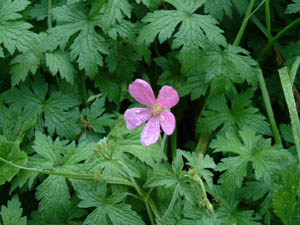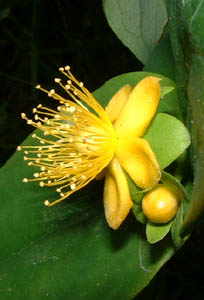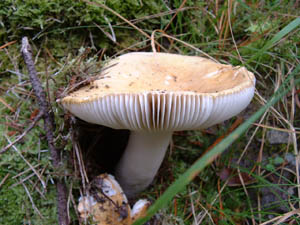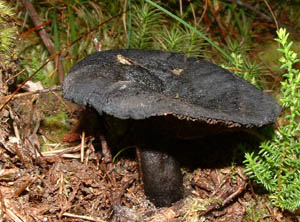September 2003
1st September
Last month, I mentioned the 'Second Spring' we are encountering, and showed the new sporing cone of the Mare's Tail. These are the spores at a magnification of x100.
Changes in humidity in the air make the "arms" change position. This is thought to aid the spores to move around and find new places to grow.
Two shots of a lovely fungus: It's about 4cm. across. The slug is a bonus.
This lichen was growing on the dead branch of a conifer.

This is an escaped Cranesbill - a member of the Geranium family
2nd September
A few weeks ago I showed the seeds of the Marsh Woundwort. These are the seeds of the Hedge Woundwort.
Here's another example of the 'Second Spring'. The first flowering of the Tutsan produced the berries at the top of the picture, but there are now new flowers forming, too. The photo on the right is a gratuitous side view of the new flower with bud.

These white moths are very common on the Hardhead.
3rd September
Two sets of mature berries, tonight. On the left the Elder berries; on the right the Woody Nightshade.
The field of Reedmace looks good, now.
4th September
 These
Rosehips are a rich source of vitamin C
These
Rosehips are a rich source of vitamin C
These are the spores of the Broad Buckler Fern at x400. They remind me of very tiny Cornish Pasties.
More Liverwort and Moss. To give some idea of scale, the larger stone chips in the photograph are about 4mm across.
5th September
Pouring rain, today.
A couple of recent images:
On the left, the flowers of the Sharp Flowered Rush. On the right, the ripe seedpod of the Dog Violet.
6th September
These are the seeds of the Common Spotted Orchid at x 100.

Astonishingly, this is the only Small Tortoiseshell butterfly I've seen this year, and I was lucky to get this bad shot.
This is the Pond Skater - an insect that walks on water.
These are the seedpods of the Shepherd's Purse - unmistakeable
7th September
This is the Yellow Bartsia - another semi-parasitic plant.
And this is Sheep's Sorrel - a tiny dock only 6" high.
8th September
Two seedheads tonight, on the left, Common Centaury; on the right, Slender St. John's Wort
This is the perfect image of synchronised eating. These caterpillars were ravaging the leaves of the Alder.
10th September
Very heavy rain, yesterday. I spent some time on statistics from the website so far.
Two spiders, tonight. The one on the right has extremely long legs for the size of its body: They extend to all edges of the picture.
And these are the seedheads of the Common Figwort:
11th September
The view
North on leg 1 has suddenly become distinctly Autumnal.
However, continuing my 'second spring' theme, here are two plants making a second push. On the left, the Meadow Buttercup, and on the right, the Bird's Foot Trefoil.
Finally, today, two mushrooms growing in the shade under the Hawthorn and ferns. Probably the Conical Fragicap.
It's clearly time for fungi, now.

This Russula was rather large: about 15cm across, growing under conifers.
And this was about 10 cm across.

This Brown Roll-Rim is very large - approx 20 cm across, with a short, off-centre stalk.
It's dangerously poisonous.

This was growing on a dead Scots Pine branch. Well, more accurately, it's a parasitic fungus that grows on another one which is actually on the branch.
(Tremella foliacea and Stereum rugosum, respectively).
Lastly, a pair of tiny, pale yellow, fungi about 1 cm across. Possibly an Omphalinum:

13th September
The
Sycamore tends to develop these Tar Spots at this time of year.
They're caused by the fungus Rhytisma acerinum.
This tiny wasp (top left) - about 1 cm long - was hunting feverishly over the new buds of the Bush Vetch. An ant and a ladybird were also working away, so I presume there was some tiny creature feeding all three.
14th September
Very wet all day, today. I manage to get these pictures during a sort of gap in the rain.
Two fungi to start. The one on the left (the Blackening Waxcap) was 2 cm across, those on the right between 1 and 1.5 cm.
And this is the seed head of the Selfheal.
15th September
This should give you a feel for the overcast nature of the evening. Leg 2 looking East.
This is the most difficult photo on the site. There was no light to focus the camera, so I had to cheat it by prefocussing on my hand in the sky, then aiming at where I thought the moth was. It's the Silver -Y moth.

16th September
Yet more fungi, today:
On the left, a lovely pair of conical mushrooms (about 2cm across). The one on the right was about 8cm.

And this last one has an olive green, very slimy cap. Again, about 8cm diameter.
And to finish, today, a close-up of a lichen.
17th September
A plethora of fungi again, today, plus a surprise at the end.
|
A Lycoperdon, I think umbratum. |
I was walking late, tonight and spotted the bat flying low over the path. I knew the camera was on flash with telephoto setting, so I just pointed and shot. Passable.
18th September
This is the
first in a three part series. These are the eggs (laid last night) of a metallic
green beetle about 4mm long.
Magnification is x100.
This is the seedhead of the Eyebright:
And this is the final stage of the Russula from September 12th. It's about 20cm across, now.
19th September
Guess what...more fungi.
First, 2 photos of another Russula - I think meirei. A toxic mushroom growing under beeches.

And this gelatinous one is called Jelly Babies -wonder why.
The cap is about 2cm across.
And another, growing on the ends of a cut pine trunk - about 10 - 15 mm across.
September 20th
 At last,
a half-decent picture of a Red Admiral.
At last,
a half-decent picture of a Red Admiral.
This rather messy group was growing on old wood shavings.
And this Polyporus badius was growing on a dead pine branch.
21st September
The cloud was very low, today. We live in the highest town in Ireland, so the clouds surrounded us for most of the day. At times like this, we can see all the spider webs on the bushes.

This Marsh Ragwort was growing on the bank of the stream.
 This
caterpillar was eating the seedhead of the Yellow Rattle
This
caterpillar was eating the seedhead of the Yellow Rattle
It looks to be the caterpillar of the Broom Moth.
A few more fungi:-
The one on the left is possibly Stropharia pseudocyanea.
22nd September
We had a forecast for localised frost last night, not sure it got that low.
So, as a (possibly last) example of the second spring, here is the Hedge Woundwort again.
The
Tutsan berries have finally gone black.
These are the seeds of the Ash. They're just beginning to turn brown and drop, now.
23rd September
This is one
of the Thorn moths - the September Thorn, I think.
There's now moss where someone found their Christmas tree a
few years ago.
Germander
Speedwell putting on a brave appearance in the face of frost.
24th September
A nice group of Hawthorn fruit, or Haws to start tonight.
And continuing with the 'second spring' theme, the Cow Parsley is back.
This is the Shaggy Ink Cap at its best. It will soon turn black and soften.
It's about 4" tall.
25th September
More fungi, the first was about 20cm across, under Beech.
The one of the left is another Lycoperdon, this time possibly perlatum, about 6cm across. The one on the right could be Hebeloma mesophaeum.
And lastly a grotesque shape, about 15 cm tall. The Common White Helvella, I think.
26th September
This is a ripe Bovista. The spores are puffed through a hole at the top when the fungus is hit by e.g. a raindrop.
A bit more colour, this time. The one on the left is sometimes known as the Fairy Bath, but all I can see is a swimming beetle. The one on the right might well be the Blackening Wax Cap again.
This one was about 10 cm across and very sticky. Probably another Russula.
27th September
I'm currently encountering far too many fungi to photograph and/or identify. I'll be showing the most interesting ones, though.
This looks be a tiny Boletus. It has spore tubes rather than gills, and is only 1 cm across.
Two mushrooms that grow on dead wood: The tiny white mushroom on the left was growing on a dead pine branch. It's only 1cm across, and extremely delicate. The dark pink ones on the right were growing on (I think) beech.
28th September
Continuing with the 'second spring' theme, the Nipplewort (left) has returned. The Dandelion is also showing again.
And the Red Clover is back, too.
This little orange caterpillar crossed the path.
 This
Hoverfly was feeding on the Ivy flower.
This
Hoverfly was feeding on the Ivy flower.
And finally, I couldn't resist another little mushroom:
29th September
These are the seedheads of the Ragwort. No wonder there are so many plants:
Two more fungi: On the left, the Orange Peel Fungus. The one on the right is 15cm across.
September 30th
Dull, dirty and raining, today. Autumn has really set in. So, on to October.
Back to Home page Back to August On to October Feedback Annexe Map News Plant list